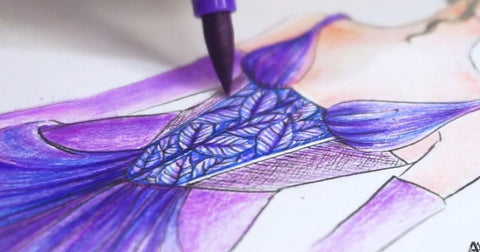Creative Ways to Color Your Next Artwork With Markers
Last Updated: July 29, 2024
"Color helps to express light—not the physical phenomenon, but the only light that really exists, that in the artist's brain." - Henri Matisse.
Do you ever feel like your artwork is missing something? Do you want to try learning a new coloring medium? If you're an artist looking for ways to switch up your color choices on future art projects, markers could be the perfect solution for you. With their versatility and range of tones, they can help add much-needed depth and detail to any work. Read on to discover how these vibrant tools can turn any flat design into a truly striking piece!

The Bold Beauty of Using Markers as an Art Medium
Markers have a unique charm in the art world. Whether it's alcohol-based or water-based markers, art markers produce an array of stunning colors and vibrancy in any project. In fact, using the best markers for coloring can bring life to your sketches and drawings!
Most markers come in different tips, such as a brush tip, chisel tip, bullet point tip, and broad tip, with some brands offering dual-tipped markers. They are easy to use, portable, reusable, and come in spectacular shades. Some art markers are even refillable, saving you more money and time by not needing to buy another set when you run out.

Artist Markers Green Fields Set
Whether you're an experienced artist experimenting with texture and layers or a beginner mastering coloring techniques, markers stand out as a medium that provides vibrant possibilities while allowing for experimentation and creativity. Moreover, markers can provide a unique opportunity to bring dimension and detail to your artwork.
No matter your level, style, or artistic vision, it's worth diving into marker techniques. You just might unlock a creative side you never knew existed!
Fun and Easy Marker Techniques

Island Garden Artist Alcohol Markers Set H
The best coloring markers are the ones that offer you a wide array of colors, high-quality nibs, and versatility when it comes to techniques. So when you buy your first set of art markers, remember to choose the ones that cater to your style and needs as an artist. Once you buy your alcohol-based or water-based markers, you can create stunning works of art easily with these must-try marker techniques:
Blending Techniques
Blending colors with markers can add depth and dimension to your artwork, and there are many techniques you can use to achieve a smooth transition between colors.

Hawaiian Shores Brush & Fine Tip Pens (Water-Based)
One marker technique is layering, which involves applying one color over another in thin layers while they’re wet. If you want to create volume for your object, we recommend using three colors to serve as your drawing’s highlight, midtone, and shadows.
- Start with your first layer, which should be the lightest color. This is your base color. Color the entire object.
- Then, lightly layer over your base color with the second color. Color until the middle part only. Blend and blur the line where the two colors meet with the lighter color.
- Lastly, use a darker color as your third color. Make sure that you do not color over the middle layer.
- Again, light color over the end of the second color, and blend the line where the two colors meet with the second color (middle layer color). This technique works best with markers with a tip that can be blended effortlessly, such as alcohol-based markers.
Another technique for blending with art markers is feathering, which involves putting the most pressure on your marker’s starting point. Then, you lightly lift the marker toward the middle area of your object or drawing, where you will blend it with another color. This gradation technique works best with markers with a brush tip, as it allows you to control the amount of color you apply.
To blend colors effectively, always remember to start with a lighter layer of color and gradually build up to darker colors and hues. Practice is key when blending with markers, so don't be afraid to experiment and try different marker techniques to find what works best for you.
Faux Watercolor Effects

Did you know that you can make beautiful watercolor looks with just markers? By using water-based marker techniques, you can make create faux watercolor effects without the mess or fuss of watercolor paint. Simply follow these steps:
- Start by gathering your supplies, which will include water-based markers in the colors of your choice, a brush, a palette with some water, and watercolor paper.
- Begin by drawing your design or image with water-based markers on the paper. You can either draw directly onto the paper or sketch your design lightly with a pencil first and then go over it with the markers.
- Next, use the brush to add water to the areas of the paper where you want to create a watercolor effect.
- As you add water to the paper, the water will cause the color from the markers to spread and blend, creating a watercolor-like effect. You can use the brush to control the amount of blending and spread of color by adding more or less water to different areas of the paper.
- Continue adding water and blending the colors until you achieve the desired effect. You can also add more color with the markers if you want to create more layers or add more intensity to certain areas.
- Once satisfied with your faux watercolor effect, allow the paper to dry completely before framing or displaying your artwork.
Texture and Patterns With Markers

English Country Garden Artist Alcohol Markers Set C
Adding texture to your artwork with markers can take your drawing or painting to the next level. From dotting to hatching, you can try different marker techniques to achieve unique textures and patterns.
- Dotting: You can do this by placing the tip of the marker on the surface and gently pressing down to create a dot. You can gently rock the marker back and forth to make a slightly oval-shaped dot or vary the size to create subtle or dramatic effects. PRO TIP: Use different shades for your dots and leave white spaces to create a glitter effect.
- Hatching: This marker technique involves creating lines that are closely spaced together to create an area of solid tone or texture. You can make the spaces between the lines evenly spaced or make them overlap with each other.
- Dragging: Drag your marker in different, uneven directions to create an unruly texture. This technique is excellent for making textures with trees, leaves, and foliage.
- Circling: Color in a circular pattern to create a curly texture. You can also use this marker technique to blur the apparent strokes when you color areas in different directions.
- Highlighting: Adding highlights can also make beautiful, realistic textures. You can do this by leaving white spaces or by using other white-colored mediums to pair with markers, such as gel pens.
Create Magic With Markers Today Using These Tips!
Indeed, markers are a versatile tool that every artist should have in their collection. They're easy to work with, versatile, and can be used for a majority of your coloring and drawing projects. By understanding the different techniques you can do with art markers, you can open up a world of endless possibilities for your creativity.
We hope these tips have encouraged you to try out markers and use them to color your next artwork. If you want more sketching and coloring tips, be sure to check back on our Creative Corner, where we regularly post new tutorials and inspiration for artists like you. Thanks for reading!
In This Article
More Inspiring Art Blogs
-

Drawing for Beginners: Get Inspired with These 10 Ideas!
-

Easy Stencil Art for Beginners
-

Learn How to Sketch Hands – Step-by-Step for Beginners!
-

10 Simple Art Techniques Everyone Can Do (Even If You’re Just Starting!)
-

From Marker to Masterpiece: Create Charming Painted Blooms with Alcohol Based Markers!
-

How to Paint Succulents: A Step-by-Step Guide to Watercolor Painting Styles
-

Discover the Magic of Subtle Texture Paste for Beautiful Mixed Media Projects!
-

Celebrate Spring with Beginner-Friendly Floral-Themed Art
-

Elevate Your Art with Acrylic Markers!
-

Layer, Blend, and Create with Permanent Markers in Fine Art












Leave a comment